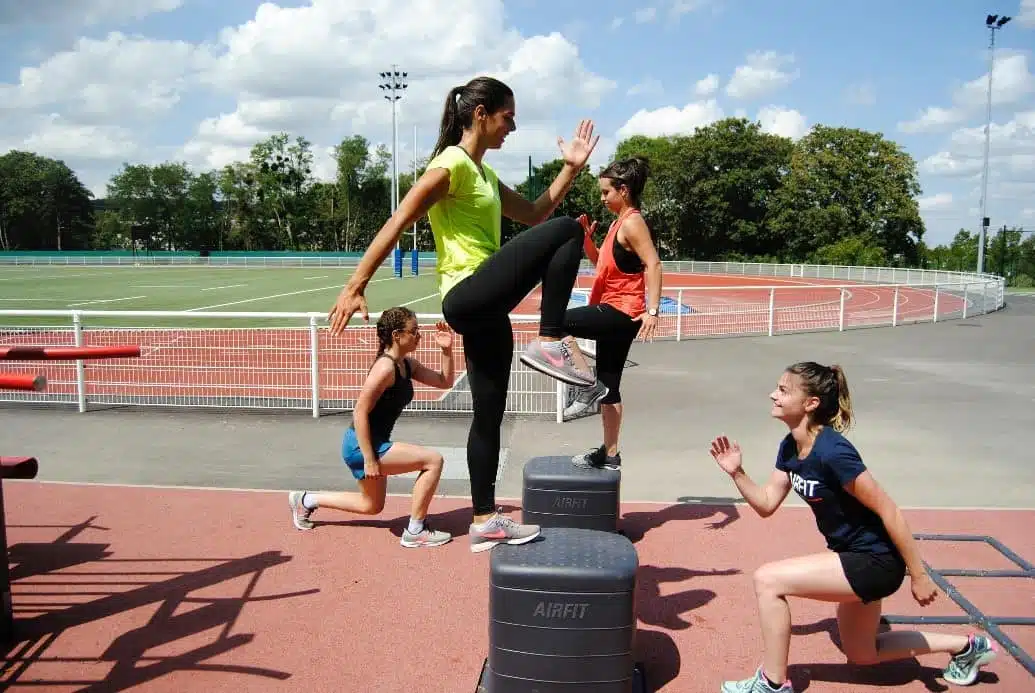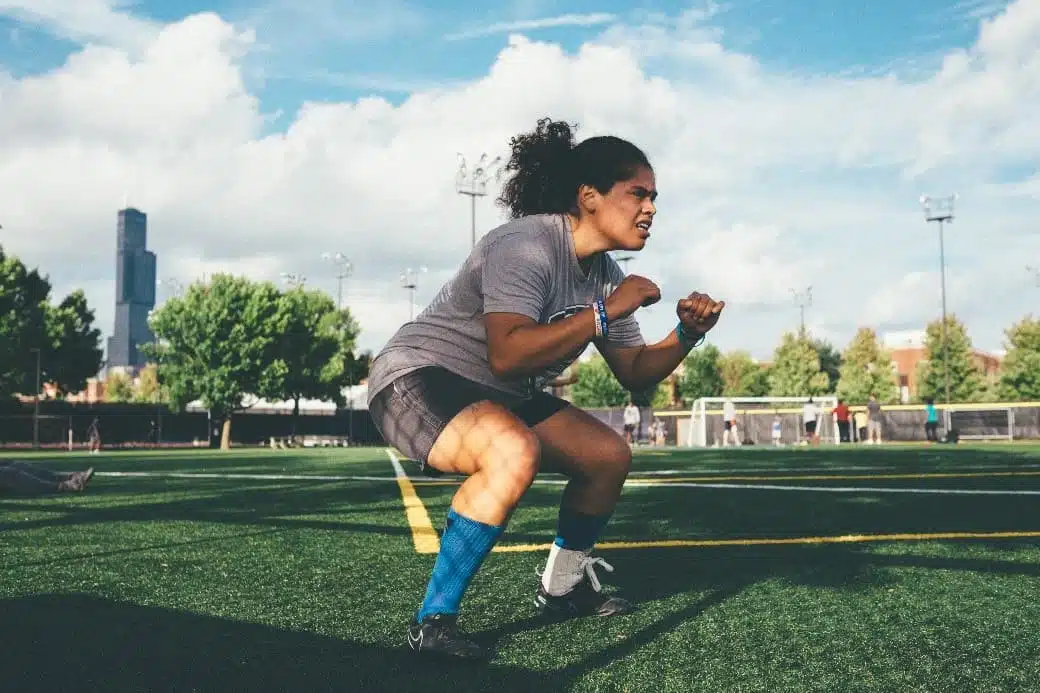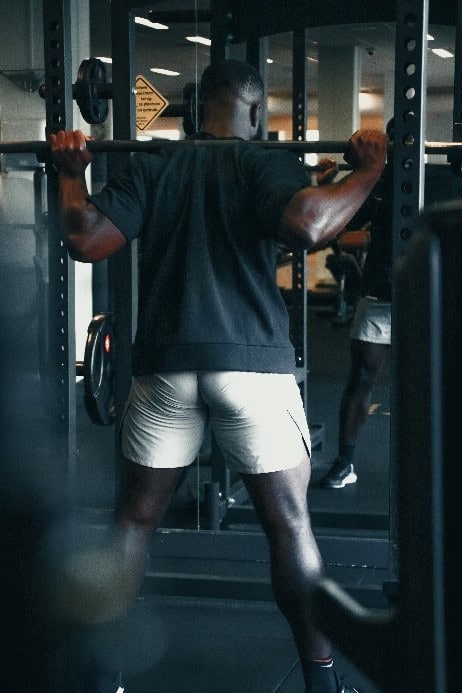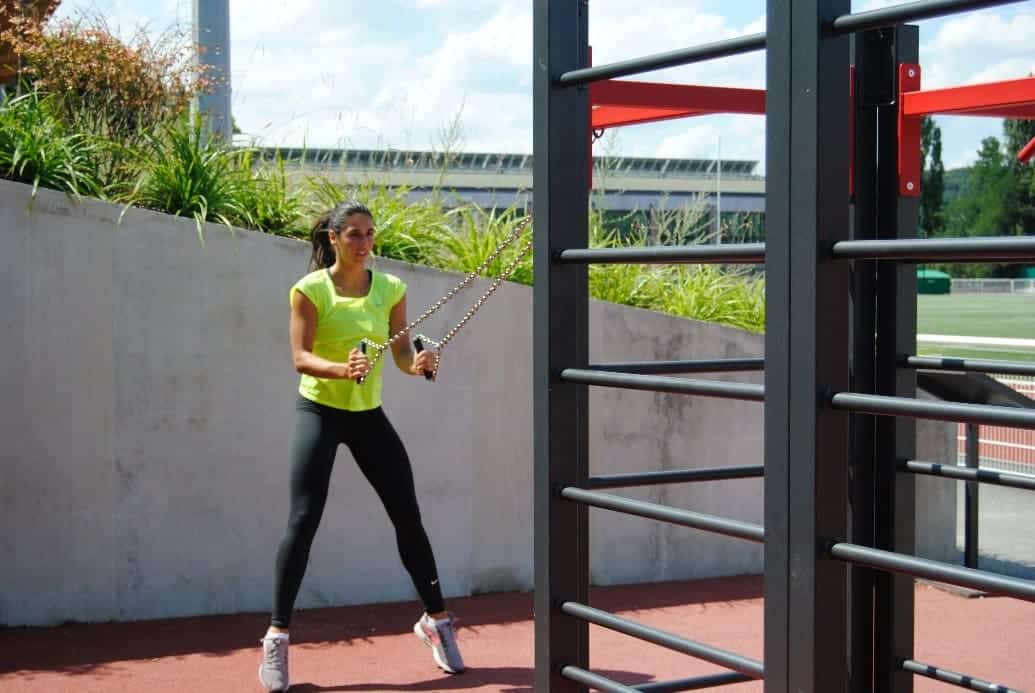24 de March de 2023
The Power Phase for Field Athletes
What are the training phases that field sports athletes go through?

The National Academy of Sports Medicine (NASM) developed an evidence-based fitness training system based on scientific principles more than 20 years ago (NASM, n.d.). Dr. Mike Clark, its creator, established five distinct but complementary training phases to improve the physical performance of field sports athletes. Optimum Performance Training Model (OPT) is the name of one of the most powerful tools we coaches have at our disposal. The five phases of the OPT model are:
Phase 1 concentrates on improving stabilization and technique. This is the starting point for new athletes or after returning from a break as a transition. The speed of execution is controlled and the intensity will be low to ensure correct form and technique of the exercises.
Phases 2, 3 and 4 are aimed at improving strength. Phase 2 focuses on strength endurance. In this second phase athletes are acclimatized to heavier weights. Phase 3 is aimed at muscle development / hypertrophy. It uses high volumes of work at moderate intensities to develop muscle mass and strength. Phase 4 develops maximal strength. It uses high loads at low speeds, although the intention will be to move them as fast as possible.
The last phase, phase 5, is known as the power phase. In this block we use high-speed strength exercises. The objective is to achieve the greatest muscular strength in the shortest time possible, transferring the strength gains acquired in the previous phases, and having a solid base and good technique that we worked on in phase 1 of stabilization.
What is the power phase for field sports athletes?

The power phase for field sport athletes utilizes the stabilization and strength adaptations acquired in the previous training phases. In field athletes, such as long jumpers, triple jumpers and high jumpers, the power phase is the phase during which they generate the maximuºm amount of force and acceleration to propel themselves forward and upward. The power phase is important for field sports athletes in a variety of disciplines, including track and field, basketball, soccer/football, etc. as it can help improve their speed, power and explosiveness.
The technical term “rate of force development” refers to the ability of the neuromuscular system to apply force as fast as possible, which is a fundamental parameter in fins that require high-speed actions (Rodriguez-Rosell, Pareja-Blanco, Aagaard, & Gonzalez-Badillo, 2018). The objective of the power phase is to increase the rate of force development, that is, to improve the athlete’s ability to generate force quickly and efficiently, allowing him to reach maximum speed and height during his jump or throw. In this phase, field sports athletes must execute muscular contractions at high speed. Knowing that power is the product of multiplying force by speed (P = F x V), we can improve this quality by increasing the loads moved (force) at the same speed, or move the same kilos (force) faster (speed).
If we achieve a combined effect and manage to do more force, and also do it faster, field sport athletes will achieve a better rate of force or power production in their sport activities (Aagaard, Simonsen, Andersen, Magnusson, & Dyhre-Poulsen, 2002). The power phase is used to increase the number of motor units that are activated in muscle contraction, that are better synchronized and that are activated in the minimum possible time (Elgueta-Cancino, Evans, Martinez-Valdes, & Falla, 2022; Freitas, Martinez-Rodriguez, Calleja-Gonzalez, & Alcaraz, 2017).
Force-velocity curve
The force-velocity curve is the inversely proportional relationship between these variables that occurs when we move a load (Alcazar, Csapo, Ara, & Alegre, 2019). The heavier a load is, the slower it moves. The lighter a load is, the faster it can move. The job of the field sports athletic coach is to program the variables with the ultimate goal of optimizing power output. We already know that P = F x V, so that power can be produced by improving either of the two components: strength or speed. A common mistake of many coaches is to abuse one of the extremes of the curve, usually the one where we move low loads at maximum velocity.
At the complete opposite extreme are slow movements with maximum loads (90% – 100% of 1RM). The movement is slow because the load cannot move any faster, but the athlete’s intention must be to move the load as fast as possible, however it looks from the outside. In between these two extremes are other forms of manifestations of force and speed:
- Maximum force (>90% of 1RM). Speed is minimal, but the strength is maximum.
- Force-velocity (80% – 90% of 1RM). Strength still dominates over velocity by using high loads close to maximums.
- Peak power (30% – 80% of 1RM). In this zone the exercises are considered to produce the maximum power, which remember is calculated with the formula P = F x V.
- Velocity-strength (30% – 60% of 1RM). Velocity begins to dominate strength as lower loads are used, allowing them to move faster.
- Maximum speed (<30% of 1RM). The use of very low loads, such as body weight, a medicine ball or similar materials, allows you to apply a maximum speed.
Training programs that combine training in each of the zones of the force-velocity curve improve athletic performance to a greater extent than focusing on one of them (Haff, Whitley, & Potteiger, 2001). Throughout the physical preparation of field athletes, we must train in each of the above areas with the ultimate goal of producing the maximum amount of force possible in the shortest amount of time. In order for the field sports athlete to transfer his athletic potential to the demands of his discipline, he must learn to use power quickly and explosively (Dietz & Van Dyke, 2012). The power phase takes care of this with a high rate of acceleration and velocity.
How long is the power phase for field sports athletes?

The power phase can last several weeks or one day, depending on the type of periodization used. A linear periodization gradually increases intensity while gradually decreasing volume (Evans, 2019). This type of model stops several weeks in each of the phases, so we will start the preparation with phase 1 of stabilization in which we will be as long as the field sports athletes need. If we come from a vacation break, this phase will be longer. If we use it as a week of unloading or transition, it will last just for a week.
In the same way we will advance through phases 2, 3 and 4 in which we will increase the loads used in each one of them, while the volume becomes less and less. The culmination of the linear periodization ends with the power phase 5 in which we will collect the fruit of all the previous work to apply it to the needs of the sport. In this linear model, the power phase begins a month or two months before the moment when we want our athlete at his peak of form. If we are going to dedicate a block of one month to the power phase, that month will be prior to the competition marked on the calendar in which the field athletes must show their maximum form.
Nonlinear periodization manipulates intensity and volume much more drastically (Fisher & Csapo, 2021). In the same training week, we can perform one day of stabilization oriented to technique with low loads, another day of maximum strength with high loads and a third day of power with explosive movements and low – medium loads. You can also use block periodization in which every week or every two weeks we focus on one manifestation of strength, so the power phase would last that long.
Undulating periodization is more suited to team sports such as baseball, soccer/football or basketball as they need to be in good shape throughout the season. If our field sports athletes have a closed discipline such as throwing or jumping in track and field, a linear periodization can also be accommodated by pinpointing two or three peaks of form throughout the season that correspond to a championship.
Therefore, more than the duration of this phase, we must first be clear about which periodization model we are going to use, and then program the sessions with loads and speeds according to our objectives. What is fundamental is that in a linear periodization the power phase is the last phase before the competition period, and that the objective of this phase is to train at very high speeds in order to be more explosive in the demands of our discipline.
It is important to keep in mind that the power phase is usually only one part of a comprehensive training program for field athletes, which also includes strength training, speed and agility work, and technical skill development. By combining these elements, athletes can optimize their physical abilities and excel in their chosen event.
How do field sports athletes train in the power phase?

In the power phase, field athletes execute explosive movements constantly to improve their power output, i.e., to generate force quickly and efficiently. If we go to the force-velocity curve discussed above, we will focus on workouts that involve moderate or low loads with high velocities, even above our maximum with the help of elastic bands. Olympic lifts with medium loads have a place in the power phase, as well as plyometric training or medicine ball throws.
Complex or contrast training for field sports athletes in the power phase
Complex or contrast training consists of combining maximal or near-maximal strength exercises with similar high-velocity movements. By combining strength and power training without rest in between, we increase power production (Cormier, Freitas, Rubio-Arias, & Alcaraz, 2020). The rationale for this contrast is to recruit muscle fibers with high loads and improve velocity and efficiency with explosive movements.
A basic example consists of performing a barbell back squat with high weights followed immediately by the execution of jump squats. For the upper body we can perform bench presses with barbell with high loads followed immediately by throwing a medicine ball from the chest against the wall. With this same dynamic we can do as many contrasts as we want.
Plyometric training for field sports athletes in the power phase
Plyometric training performed explosively, is one of the key ways to work on the power phase. This velocity-oriented work method improves muscle power (Zaras et al., 2013). When a high jumper performs the last support before the jump, his tissues must absorb the impact and then, in milliseconds, produce the maximum force possible to get over the bar. Plyometrics is used for this task, since it consists of performing stretch-shortening cycles (that rapid support on the ground). This action occurs in countless sporting gestures, whether in jumps, throws with previous arming, changes of direction, etc.
Olympic Lifts for Field Sports Athletes in the Power Phase
Olympic lifts require us to accelerate a load as quickly as possible to have time to get under the bar. That is the quality we seek to improve in the power phase, moving a load as fast as possible, because that way we increase the rate of force development (James, Suchomel, Comfort, Haff, & Connick, 2022). The great advantage of the Olympic movements is that moderate loads can be moved at high velocity, something that does not happen in other lifts.. The downside is that the Olympic lifts are very technical, so if our field athletes don’t know how to execute them, we can perform simpler variants of Olympic lifts.
Elastic band assistance for field athletes in the power phase
Elastic bands can be used to assist us in lifts or to make them more complex. As we seek to make our neural connections as fast as possible in the power phase, assistance with elastic bands will allow us to reach supramaximal speeds (Tufano et al., 2018). The following videos are two examples of this training method, in which we use elastic bands to perform jumps and push-ups with a speed above the maximum we would achieve without them.
Individualized power training based on maximum power output
Beyond the exercises and methods used in the power phase, the important thing is to individualize the load used by each athlete. A velocity measuring device such as Vitruve’s instantaneously calculates the power for each lift. This data helps us to control whether the program is effective in improving power, and also to control fatigue, by cutting the series when we lose a certain velocity (Picerno et al., 2016). By training only with the repetitions in which we maintain maximal power production, we push away fatigue and individualize training for each field athlete (Sarabia, Moya-Ramón, Hernández-Davó, Fernandez-Fernandez, & Sabido, 2017).
With the use of velocity-based training, we will reduce volume by performing only useful repetitions. This allows us to train more frequently and with less fatigue, a combo that field sports athletes will see significant improvements over doing so without the use of velocity measuring devices.
Joaquin Vico Plaza
References
Aagaard, P., Simonsen, E. B., Andersen, J. L., Magnusson, P., & Dyhre-Poulsen, P. (2002). Increased rate of force development and neural drive of human skeletal muscle following resistance training. Journal of Applied Physiology (Bethesda, Md. : 1985), 93(4), 1318–1326. https://doi.org/10.1152/JAPPLPHYSIOL.00283.2002
Alcazar, J., Csapo, R., Ara, I., & Alegre, L. M. (2019). On the Shape of the Force-Velocity Relationship in Skeletal Muscles: The Linear, the Hyperbolic, and the Double-Hyperbolic. Frontiers in Physiology, 10(JUN). https://doi.org/10.3389/FPHYS.2019.00769
Cormier, P., Freitas, T. T., Rubio-Arias, J., & Alcaraz, P. E. (2020). Complex and Contrast Training: Does Strength and Power Training Sequence Affect Performance-Based Adaptations in Team Sports? A Systematic Review and Meta-analysis. Journal of Strength and Conditioning Research, 34(5), 1461–1479. https://doi.org/10.1519/JSC.0000000000003493
Dietz, C., & Van Dyke, M. (2012). Triphasic Training: A Systematic Approach to Elite Speed and Explosive Strength Performance, 154.
Elgueta-Cancino, E., Evans, E., Martinez-Valdes, E., & Falla, D. (2022). The Effect of Resistance Training on Motor Unit Firing Properties: A Systematic Review and Meta-Analysis. Frontiers in Physiology, 13, 817631. https://doi.org/10.3389/FPHYS.2022.817631/FULL
Evans, J. W. (2019). Periodized Resistance Training for Enhancing Skeletal Muscle Hypertrophy and Strength: A Mini-Review. Frontiers in Physiology, 10(JAN). https://doi.org/10.3389/FPHYS.2019.00013
Fisher, J. P., & Csapo, R. (2021). Periodization and Programming in Sports. Sports (Basel, Switzerland), 9(2). https://doi.org/10.3390/SPORTS9020013
Freitas, T. T., Martinez-Rodriguez, A., Calleja-González, J., & Alcaraz, P. E. (2017). Short-term adaptations following Complex Training in team-sports: A meta-analysis. PLoS ONE, 12(6). https://doi.org/10.1371/JOURNAL.PONE.0180223
Haff, G. G., Whitley, A., & Potteiger, J. A. (2001). A brief review: Explosive exercises and sports performance. Strength & Conditioning Journal, 23(3), 13.
James, L. P., Suchomel, T. J., Comfort, P., Haff, G. G., & Connick, M. J. (2022). Rate of Force Development Adaptations After Weightlifting-Style Training: The Influence of Power Clean Ability. Journal of Strength and Conditioning Research, 36(6), 1560–1567. https://doi.org/10.1519/JSC.0000000000003673
NASM. (n.d.). The Optimum Performance Training Model – NASM. Retrieved March 23, 2023, from https://www.nasm.org/certified-personal-trainer/the-opt-model
Picerno, P., Iannetta, D., Comotto, S., Donati, M., Pecoraro, F., Zok, M., … Piacentini, M. F. (2016). 1RM prediction: a novel methodology based on the force-velocity and load-velocity relationships. European Journal of Applied Physiology, 116(10), 2035–2043. https://doi.org/10.1007/S00421-016-3457-0
Rodríguez-Rosell, D., Pareja-Blanco, F., Aagaard, P., & González-Badillo, J. J. (2018). Physiological and methodological aspects of rate of force development assessment in human skeletal muscle. Clinical Physiology and Functional Imaging, 38(5), 743–762. https://doi.org/10.1111/CPF.12495
Sarabia, J. M., Moya-Ramón, M., Hernández-Davó, J. L., Fernandez-Fernandez, J., & Sabido, R. (2017). The effects of training with loads that maximise power output and individualised repetitions vs. traditional power training. PLoS ONE, 12(10). https://doi.org/10.1371/JOURNAL.PONE.0186601
Tufano, J. J., Malecek, J., Steffl, M., Stastny, P., Hojka, V., & Vetrovsky, T. (2018). Field-Based and Lab-Based Assisted Jumping: Unveiling the Testing and Training Implications. Frontiers in Physiology, 9(SEP). https://doi.org/10.3389/FPHYS.2018.01284
Zaras, N., Spengos, K., Methenitis, S., Papadopoulos, C., Karampatsos, G., Georgiadis, G., … Terzis, G. (2013). Effects of Strength vs. Ballistic-Power Training on Throwing Performance. Journal of Sports Science & Medicine.

